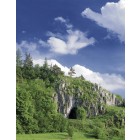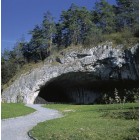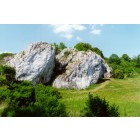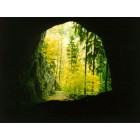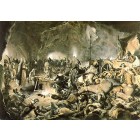The geology of the region
The oldest rocks in the Moravian Karst are known as the Brno volcanic rocks. They were evidently formed before the Palaeozoic age and during the Devonian, the youngest period of the early Palaeozoic, and were for the most part submerged by the sea, during which time various agglomerations, sandstones and limestones were deposited on top of them. The limestone layers reached a thickness of as much as a thousand metres. During the next period – the Carboniferous – clay and sand were carried to the sea basin to form slates, wacke and agglomerations. When the Carboniferous sea retreated, the deposited rocks were buckled and broken (folded) and the newly created landmass became a mountain range. It was gradually lowered and levelled in shape – this process continued until the middle of the Jurassic (the middle period of the Mesozoic), when the Moravian Karst and the surrounding area was again flooded by a shallow sea in which layers of limy sandstones and limestones not particularly thick were deposited. After the sea receded, the surface of the rock was subjected to strong weathering. Weathered rock in the form of clays and sands was deposited in funnel-shaped depressions similar to sink holes. These contained a large quantity of iron ore, which was mined as early as prehistoric times and formed the basis for the iron industry in the Moravian Karst; these are known as the Rudice layers. The next sea – the Cretaceous – did not have a great impact on the relief of the landscape. The oldest valleys were formed in the early Tertiary period, and became even deeper during Alpine-Carpathian folding, though they were later partially filled with sediments from the late Tertiary (lower Tortonian) sea, primarily clays and sands. These survive to this day only in the deep valleys. The landscape took on its principal features, therefore, before its flooding by the late Tertiary sea. It was, however, given its definitive form by water acting on the soluble limestone bedrock.
History
The Moravian Karst has an extremely long and extensive history of settlement. Practically all the most notable caves are significant archaeological localities. They provide evidence of the fact that dry spaces underground were used by prehistoric man practically uninterruptedly from the Early Stone Age (the Mousterian, around 100,000 years ago). The oldest evidence of human settlement in this area comes from this period – the jaw of a Neanderthal found in the Švédský Stůl (Swedish Table) Cave and part of a Neanderthal jaw from the Kůlna Cave. Mammoth hunters also lived temporarily in the karst – evidence of them has been found in the Pekárna, Býčí Skála and Kůlna caves and in the area in front of the Ochoz Cave. The mammoth hunters gave way to reindeer hunters of the Magdalenian culture (13,000–10,000 B.C.) who left unique carvings on bones and antlers that have been found by archaeologists, along with other objects, in the Pekárna Cave. The reindeer hunters also settled in other caves, for example Kůlna, Jáchymka and Výpustek.
In the Middle Stone Age (8,000– 7,000 B.C.) prehistoric man left the caves for good thanks to the warming of the climate and resettled on elevated terrain. In the Late Stone Age (3,000–1,000 B.C.) man began to engage in agriculture and cattle rearing. The Únětice culture of the Bronze Age did not have a particularly profound impact on the area. The world-famous burial site of a tribal leader with human sacrifices at Býčí Skála comes from the time of the Horákov culture (the seventh–sixth centuries B.C.).
The Celts came to the Moravian Karst in the last centuries B.C., followed by the Teutons and then the Slavs. The karst area became part of the Great Moravian Empire and one of its oldest settlements – Staré Zámky – became an important administrative centre in the area, rich in iron ore, as did the predecessor to the castle and town of Brno (under the name Veligrad). The region around Blansko, Boskovice, Rájec and Jedovnice was also gradually colonised in addition to the Brno area. The main coloniser here was the diocese of Olomouc, though secular feudal lords were also involved. The first towns (e.g. Blansko – first mentioned in 1136, holding town status since 1905) were formed from the old Slavic settlements on trading routes and near iron ore mines and castles. Production developed rapidly – in addition to the extraction of deposits of iron ore and ore smelting works, lime was also burned in the area, wood was made into charcoal in charcoal kilns, and there was a significant expansion in trade. New settlements found it difficult to resist enemy incursions such as the invasions by the Cumans (1237) and the Tatars (1241).
The Hussite movement had an enormous effect on the population of the Moravian Karst, with both serfs and many feudal lords, such as the Lords of Boskovice and the Knights of Holštejn, joining the movement. An important enemy of the Hussites was Bishop of Olomouc Jan Železný who, with help from Brno and Albrecht of Austria, captured all the castles in the karst loyal to the chalice. The occupied castles were regained during a retaliatory campaign by the Hussites headed by Jan Hvězda of Vicemilice and the bishop’s possessions were heavily plundered. The Hussites, this time headed by Prokop Holý, conquered Blansko (the castle and the fort) and Holštejn in another military campaign in 1430–1431. The wars did not come to an end even during the reign of George of Poděbrady, when Moravia temporarily fell into the hands of Matthias Corvinus. Many villages simply disappeared during this time.
The relative calm and prosperity of the sixteenth century was followed by the Uprising of the Estates of 1618 and the Thirty Years’ War which brought further hardship and suffering. Additional villages were destroyed during the Swedish occupation, and Nový Hrad fell into Swedish hands as the result of an act of treachery. The end of the seventeenth century and the eighteenth century saw a revival to the economy. New ironworks and glassworks were established, iron and sometimes coal were mined, and agriculture developed. The height of iron production came in the nineteenth century with the use of new production methods, concentrated largely in the Blansko, Adamov and Jedovnice area. There was an awakening nationalist movement in the country – the first associations were formed and the labour movement became organised. Social democracy is particularly strong in the Blansko area.
Construction of the Brno – Česká Třebová – Prague railway line was of great importance to the development of the Blansko region. The Brno – Blansko section was built in 1843–1849 by the Italian company Tallachini.
Many branches of industry, and the iron industry in particular, enjoyed a boom following the establishment of Czechoslovakia. The towns began to show a modern face and organised tourism brought many admirers of underground beauty spots to the Moravian Karst from all over Czechoslovakia and abroad. The German occupation of 1939–1945 claimed many victims, with groups of partisans operating in some places, particularly towards the end of the war. Certain villages (Senetářov and the surrounding area) were evacuated and turned into German firing ranges. German armaments factories were established in a number of caves (Výpustek).
Another period of industrial development was seen after the war, with associated housing construction that is particularly evident in Adamov and Blansko. Thanks to their unique karst formations, well-preserved monuments and well-developed tourist infrastructure, the Blansko region and the Moravian Karst have become popular tourist destinations.
Welcome to the Moravian Karst!
The oldest rocks in the Moravian Karst are known as the Brno volcanic rocks. They were evidently formed before the Palaeozoic age and during the Devonian, the youngest period of the early Palaeozoic, and were for the most part submerged by the sea, during which time various agglomerations, sandstones and limestones were deposited on top of them. The limestone layers reached a thickness of as much as a thousand metres. During the next period – the Carboniferous – clay and sand were carried to the sea basin to form slates, wacke and agglomerations. When the Carboniferous sea retreated, the deposited rocks were buckled and broken (folded) and the newly created landmass became a mountain range. It was gradually lowered and levelled in shape – this process continued until the middle of the Jurassic (the middle period of the Mesozoic), when the Moravian Karst and the surrounding area was again flooded by a shallow sea in which layers of limy sandstones and limestones not particularly thick were deposited. After the sea receded, the surface of the rock was subjected to strong weathering. Weathered rock in the form of clays and sands was deposited in funnel-shaped depressions similar to sink holes. These contained a large quantity of iron ore, which was mined as early as prehistoric times and formed the basis for the iron industry in the Moravian Karst; these are known as the Rudice layers. The next sea – the Cretaceous – did not have a great impact on the relief of the landscape. The oldest valleys were formed in the early Tertiary period, and became even deeper during Alpine-Carpathian folding, though they were later partially filled with sediments from the late Tertiary (lower Tortonian) sea, primarily clays and sands. These survive to this day only in the deep valleys. The landscape took on its principal features, therefore, before its flooding by the late Tertiary sea. It was, however, given its definitive form by water acting on the soluble limestone bedrock.
History
The Moravian Karst has an extremely long and extensive history of settlement. Practically all the most notable caves are significant archaeological localities. They provide evidence of the fact that dry spaces underground were used by prehistoric man practically uninterruptedly from the Early Stone Age (the Mousterian, around 100,000 years ago). The oldest evidence of human settlement in this area comes from this period – the jaw of a Neanderthal found in the Švédský Stůl (Swedish Table) Cave and part of a Neanderthal jaw from the Kůlna Cave. Mammoth hunters also lived temporarily in the karst – evidence of them has been found in the Pekárna, Býčí Skála and Kůlna caves and in the area in front of the Ochoz Cave. The mammoth hunters gave way to reindeer hunters of the Magdalenian culture (13,000–10,000 B.C.) who left unique carvings on bones and antlers that have been found by archaeologists, along with other objects, in the Pekárna Cave. The reindeer hunters also settled in other caves, for example Kůlna, Jáchymka and Výpustek.
In the Middle Stone Age (8,000– 7,000 B.C.) prehistoric man left the caves for good thanks to the warming of the climate and resettled on elevated terrain. In the Late Stone Age (3,000–1,000 B.C.) man began to engage in agriculture and cattle rearing. The Únětice culture of the Bronze Age did not have a particularly profound impact on the area. The world-famous burial site of a tribal leader with human sacrifices at Býčí Skála comes from the time of the Horákov culture (the seventh–sixth centuries B.C.).
The Celts came to the Moravian Karst in the last centuries B.C., followed by the Teutons and then the Slavs. The karst area became part of the Great Moravian Empire and one of its oldest settlements – Staré Zámky – became an important administrative centre in the area, rich in iron ore, as did the predecessor to the castle and town of Brno (under the name Veligrad). The region around Blansko, Boskovice, Rájec and Jedovnice was also gradually colonised in addition to the Brno area. The main coloniser here was the diocese of Olomouc, though secular feudal lords were also involved. The first towns (e.g. Blansko – first mentioned in 1136, holding town status since 1905) were formed from the old Slavic settlements on trading routes and near iron ore mines and castles. Production developed rapidly – in addition to the extraction of deposits of iron ore and ore smelting works, lime was also burned in the area, wood was made into charcoal in charcoal kilns, and there was a significant expansion in trade. New settlements found it difficult to resist enemy incursions such as the invasions by the Cumans (1237) and the Tatars (1241).
The Hussite movement had an enormous effect on the population of the Moravian Karst, with both serfs and many feudal lords, such as the Lords of Boskovice and the Knights of Holštejn, joining the movement. An important enemy of the Hussites was Bishop of Olomouc Jan Železný who, with help from Brno and Albrecht of Austria, captured all the castles in the karst loyal to the chalice. The occupied castles were regained during a retaliatory campaign by the Hussites headed by Jan Hvězda of Vicemilice and the bishop’s possessions were heavily plundered. The Hussites, this time headed by Prokop Holý, conquered Blansko (the castle and the fort) and Holštejn in another military campaign in 1430–1431. The wars did not come to an end even during the reign of George of Poděbrady, when Moravia temporarily fell into the hands of Matthias Corvinus. Many villages simply disappeared during this time.
The relative calm and prosperity of the sixteenth century was followed by the Uprising of the Estates of 1618 and the Thirty Years’ War which brought further hardship and suffering. Additional villages were destroyed during the Swedish occupation, and Nový Hrad fell into Swedish hands as the result of an act of treachery. The end of the seventeenth century and the eighteenth century saw a revival to the economy. New ironworks and glassworks were established, iron and sometimes coal were mined, and agriculture developed. The height of iron production came in the nineteenth century with the use of new production methods, concentrated largely in the Blansko, Adamov and Jedovnice area. There was an awakening nationalist movement in the country – the first associations were formed and the labour movement became organised. Social democracy is particularly strong in the Blansko area.
Construction of the Brno – Česká Třebová – Prague railway line was of great importance to the development of the Blansko region. The Brno – Blansko section was built in 1843–1849 by the Italian company Tallachini.
Many branches of industry, and the iron industry in particular, enjoyed a boom following the establishment of Czechoslovakia. The towns began to show a modern face and organised tourism brought many admirers of underground beauty spots to the Moravian Karst from all over Czechoslovakia and abroad. The German occupation of 1939–1945 claimed many victims, with groups of partisans operating in some places, particularly towards the end of the war. Certain villages (Senetářov and the surrounding area) were evacuated and turned into German firing ranges. German armaments factories were established in a number of caves (Výpustek).
Another period of industrial development was seen after the war, with associated housing construction that is particularly evident in Adamov and Blansko. Thanks to their unique karst formations, well-preserved monuments and well-developed tourist infrastructure, the Blansko region and the Moravian Karst have become popular tourist destinations.
Welcome to the Moravian Karst!


